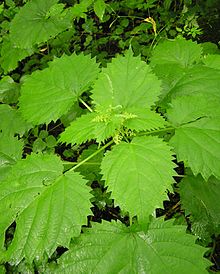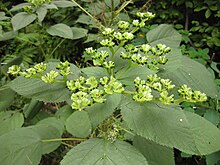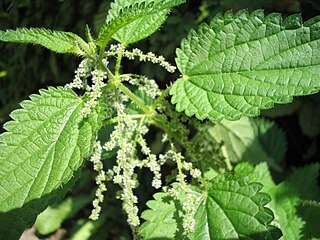
The Urticaceae are a family, the nettle family, of flowering plants. The family name comes from the genus Urtica. The Urticaceae include a number of well-known and useful plants, including nettles in the genus Urtica, ramie, māmaki, and ajlai.

Urtica is a genus of flowering plants in the family Urticaceae. Many species have stinging hairs and may be called nettles or stinging nettles, although the latter name applies particularly to Urtica dioica.
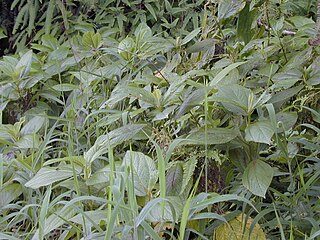
Boehmeria is a genus of 47 species of flowering plants in the nettle family Urticaceae. Of the species, 33 are indigenous to the Old World and 14 to the New World; no species is indigenous to both the Old and New Worlds. The species include herbaceous perennials, shrubs and small trees. Although related to the similar-looking species of the stinging nettles of genus Urtica, species of Boehmeria do not have stinging hairs. Because of the similarity in appearance, some species are commonly called "false nettles".
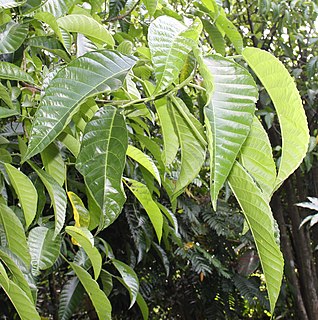
Dendrocnide is a genus of approximately 40 species of plants in the nettle family Urticaceae. They have a wide distribution across North East India, Southeast Asia, Australia and the Pacific Islands. In Australia they are commonly known as stinging trees.

Dendrocnide moroides, commonly known in Australia as the stinging tree, stinging bush or gympie-gympie, is a plant in the nettle family Urticaceae found in rainforest areas of Malaysia and Australia. It is notorious for its extremely painful and long-lasting sting. The common name gympie-gympie comes from the language of the Indigenous Gubbi Gubbi people of south-eastern Queensland.

Urera is a genus of flowering plants in the nettle family, Urticaceae. It has a pantropical distribution.
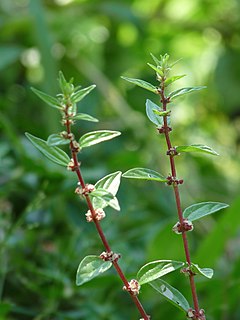
Pouzolzia is a genus of flowering plants in the nettle family. There are about 35 species distributed throughout the tropical world. Most are shrubs, and some are herbs. The genus was named for French botanist and plant collector Pierre Marie Casimir de Pouzolz (1785–1858).
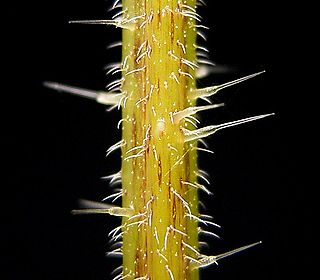
A stinging plant or a plant with stinging hairs is a plant with hairs (trichomes) on its leaves or stems that are capable of injecting substances that cause pain or irritation.
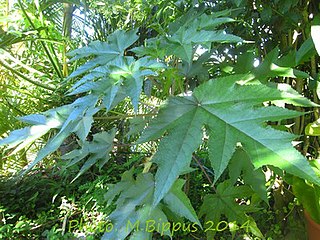
Obetia is a genus of dioecious plants in the family Urticaceae, with stinging hairs. The genus contains the following species:

Urera trinervis (Hochst.) Friis & Immelman is a softly woody dioecious liane, sometimes epiphytic, climbing to 20 m, often to the canopy and hanging in festoons. It is one of some 44 species of Urera belonging to the nettle family Urticaceae. It is known in English as the tree climbing-nettle or climbing nettle.

Laportea grossa, or spotted nettle, is an African plant in the family Urticaceae, and one of 31 species in the genus. This species occurs in shady places in coastal and escarpment forests, closed woodland and on streambanks from George through the Eastern Cape, KwaZulu-Natal to southern Mozambique. Young leaves of this species are cooked and eaten as a vegetable.
Cypholophus is a genus of flowering plants belonging to the family Urticaceae.

Girardinia is a genus of flowering plants belonging to the family Urticaceae.

Droguetia is a genus of flowering plants belonging to the family Urticaceae.
Lecanthus is a genus of flowering plants belonging to the family Urticaceae.
Oreocnide is a genus of flowering plants belonging to the family Urticaceae.

Dendrocnide cordifolia, commonly known as the stinging tree, is a plant in the nettle family Urticaceae endemic to the Atherton Tablelands, south west of Cairns, Queensland. Contact with the plant results in a painful sting, however the intensity and duration of the pain from this plant is extreme.
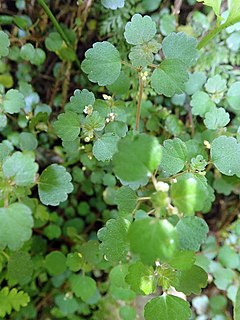
Australina pusilla, the small shade nettle, is a species of flowering plant in the family Urticaceae, native to eastern Australia, and New Zealand. A highly variable perennial herb reaching 50 cm (20 in), it is often found growing alongside shady streams.
Dendrocnide corallodesme, the mango-leafed stinger, is a species of flowering plant in the nettle family Urticaceae, native to New Guinea and Queensland. It is a rainforest tree reaching 6 m (20 ft), with irritating hairs on its flowers and abaxial leaf midribs.
